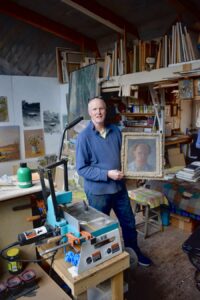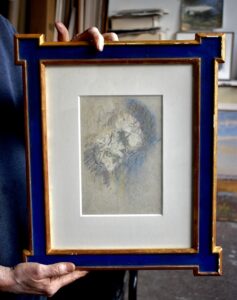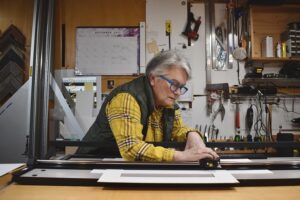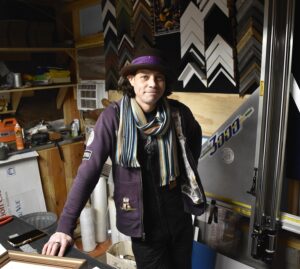Beveled or square-edged, gold or chartreuse, deep-set or floater? Does a frame enhance a work of art?
The frame is a statement, a declaration by the artist. Finding a suitable frame for a piece is important to galleries, museums, auction houses, and patrons. When art lovers come across a desirable work, often their first impulse is to frame it.

“Certain artists designed frames so that the frame was an integral part of the experience,” says Provincetown painter John Dowd. Frames can alter how paintings are seen. “A baroque painting in a Victorian frame changes the feeling of it,” says Dowd.
“You can make a picture look great with a commercial frame,” he adds. “But if you’re sensitive and sophisticated enough to have something made for you that fits — Rob DuToit’s frames are like hand-tailoring versus off-the-rack.”
In his studio on Miller Hill Road in Provincetown, DuToit holds a gilt-edged Florentine frame with turned corners and a cobalt panel. He made it years ago when he was living in a potting shed in Wellfleet. “Everything is from scratch,” he says. “That’s all my molding.”
DuToit worked for the legendary New York framer Herbert Benevy in the early 1980s. “I started mostly with the grunt work,” he says. Eventually, DuToit was doing the gilding and finishing because Benevy was going blind.
DuToit makes the frame, joins it, sands it flat, and then makes gesso (a painting prime) out of whiting and rabbit skin glue. He uses three coats of hard gesso, which has more glue, and then 14 coats of soft gesso on top. “The soft gesso sands beautifully,” he says. “It comes out like mirror finish.”
He rubs red gilding clay over the sanded gesso, noting that the clay has gone from $60 per kilo to $300 or $400 because the German company that makes it went out of business. “It’s like a dollar a crumb,” he says, as bits of red clay fall from the bag. “I’m stocking up before it becomes extinct.”
DuToit grinds the clay in a rock tumbler with beach stones for 24 hours, then thins it with water. He mixes the concoction with glue until he gets exactly three drops of clay dripping off his brush. Five coats of this are applied to the frame.
Liquor is then mixed with gelatin and applied to the clay, activating the glue from the gesso underneath it. When the glue rises, DuToit grabs a gilder’s tip to lay strips of six-carat white gold onto the frame. The gold crumbles to dust if you touch it with your hands, but with the gilder’s tip it will “jump off and suck right down onto the frame,” he says. He dabs the gold onto the frame with cotton. “Once that’s finished you can either shellac or lacquer it to seal it,” he says. Easy-breezy.
DuToit waits until the frame is dry and rubs it with agate stone, a type of hard quartz. He will often tone modern frames down by putting umber in the shellac.
“Rotten stone,” slate pulverized into powder, is the final touch to polish the frame.
DuToit pulls out a Herbert Benevy frame with orange clay and flecks of gold in its troughs and crests. “This is classic — these heavy patina finishes and gray casing washes on top,” he says. In the frame is a DuToit self-portrait.
“The frame is the boundary with the world,” he says. “It creates a beautiful interface with the environment. You should see the painting and not really be aware of the frame.”
When DuToit gets tired of looking at paintings in museums, he looks at the frames. His favorite period of framing is the painted gray slopes of the post-war era. “They’d take crude scoured wood and put gesso on it, sand it, and gild a highlight,” he says.
DuToit grabs another frame. “This is ebonized walnut,” he says. “You know when you go to old cobbler shops and there’s that really intense toxic smell? That’s the shoe leather dye. You rub that down on the walnut and it has a shiny but not tarty gloss to it.”

Benevy taught DuToit that finishes should never be even. “There needs to be something about it that’s handmade and has character,” he says. “So, it’s not like something you sprayed on.”
Provincetown architect and assemblage artist Ted Chapin says, “When I did 2D art I framed stuff — I’d go to stores that sold ready-made frames just to save money.”
Chapin owned his own frame shop on Haight Street in San Francisco in the ’70s. “I don’t even think it had a name,” he says. The shop was in the back of his seven-room Victorian flat.
“I learned certain tricks,” he says. “The bottom of the mat should be more than the top by about a quarter inch.” He says that lifts the picture. The difference is so small that you don’t see it at first glance.
Chapin says the wood used in framing must be completely dried or it can pull away from the miter. “You need small nails to attach it, and glue,” he says. “The miter needs to be dead on 45 degrees, or it’s going to be screwy looking.
“The depth of a frame is the cost difference. If you go 2½ inches deep, it has an incredible weightiness to it,” says Chapin. “The cheap frames usually are not deep. A deep frame is sexier. Generally speaking, wood is sexier than metal and usually costs more, too.”
Chapin got out of the business after a large piece of glass broke while he was holding it. “I rushed out bleeding into the street clutching a rag around my hand,” he says. A neighbor drove him to the hospital, and the next day he had micro-surgery to reconnect the nerves to one of his fingers.
Chapin says the only framer he uses in Provincetown is Lynn Cicchetti. “I had a portrait of myself in Palm Springs framed,” he says. “Lynn made a wood frame with a silver finish.”

Cicchetti is cutting a mat inside a garage on Allerton Street in Provincetown’s East End. “It’s about time someone did a story about framers,” she says. “We’re the last touch on a painting.”
Cicchetti has been framing for 45 years and owns Under Glass Custom Framing. “Once you become familiar and comfortable with it, then you take chances,” she says. Cicchetti is mostly self-taught; her specialty is art deco framing.
She ran a frame shop on Church Street in San Francisco for two decades before moving to Provincetown, where she opened a shop behind Bowersock Gallery. She operated there for nine years until her landlord decided to use the space for storage during the pandemic. Cicchetti packed up and moved the operation to her garage where, she says, “there’s no overhead.” She says all of her customers followed her.
“In framing, you’re only working with an eighth of an inch,” she says. “If it’s an 8-by-10 frame, you make it 8 1/8 by 10 1/8, so that everything goes in.”
She tries to lead customers to what looks good. Sometimes, though, “inside, in my silent voice, I’m saying what?” she says.
She cuts the wood on a giant teal chopper that spans half the garage. Her compressor roars like a lawn mower, joining two wood pieces at a perfect right angle. She adjusts her blue-rimmed glasses in satisfaction.
Cicchetti framed 45 works last year for Anne Packard’s retrospective. “They wanted double mats with a weighted bottom, which means the bottom is wider,” she says.
Chris Wilcox is the owner of Framed on Howland Street in Provincetown’s East End. “My mom was a framer,” he says. “I grew up doing this.” Terry Downey, Wilcox’s mother, had a frame studio in the attic. Wilcox’s first job was helping her break glass into the glass bin.

“We’re a small industry,’ he says. “The Suez Canal blockage screwed up the lumber industry in 2020, and we might be looking at another recession in the industry again.”
Wilcox says Cicchetti and DuToit have been his mentors through the process of opening his own business. “I’m excited to be a part of the new generation of framers here,” he says.
